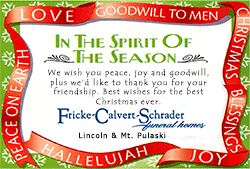|
 To help keep your holiday season healthy, the U.S. Department of
Agriculture’s (USDA) Food Safety and Inspection Service (FSIS) is
issuing holiday inspired food safety recommendations for your
Christmas, Hanukkah, Kwanzaa, New Year’s Eve, Three Kings Day, or
other festive gatherings. To help keep your holiday season healthy, the U.S. Department of
Agriculture’s (USDA) Food Safety and Inspection Service (FSIS) is
issuing holiday inspired food safety recommendations for your
Christmas, Hanukkah, Kwanzaa, New Year’s Eve, Three Kings Day, or
other festive gatherings.
These tips come from years of experience working to make sure
that the meat, poultry and egg products you eat are safe, wholesome
and properly labeled. To start, download the FoodKeeper
application. This smartphone and tablet app created by FSIS will
help you evaluate what items in your refrigerator and pantry are
still good and what may be past its prime.
As you’re putting together dishes for meals at home or parties at
work, it will help you make sure you’re using fresh ingredients.

The FoodKeeper offers storage advice on more than 400 different
food and beverage items and can help you decide what you can keep
and what you should throw out. It also offers handy guidance on
leftovers, which you’ll probably have a lot of after the big meal.
Download the FoodKeeper today on your Android or iOS device.
Steps to Follow When Cooking a Holiday Roast:
Use separate cutting boards, plates and utensils for raw
roasts and cooked roasts to avoid cross-contamination.
Wash items such as cutting boards that have touched raw meat
with warm water and soap, or place them in a dishwasher.
To avoid overcooking beef, veal, pork and lamb roasts use a
meat thermometer. These roasts should be removed from the oven when
they reach an internal temperature of 145 °F and allowed to rest for
three minutes before serving.
Turkey, duck, and goose should be cooked to an internal
temperature of 165 °F as measured by a food thermometer.
Temperatures should be taken in three areas of the bird: the
thickest part of the breast, the innermost part of the wing, and the
innermost part of the thigh.
Food Safety Tips for Holiday Party Buffets:
Keep hot food hot and keep cold food cold by using chafing
dishes or crock pots and ice trays. Hot items should remain above
140 ˚F and cold items should remain below 40 ˚F.
Use several small plates when serving food.
Discard perishable foods left out for 2 hours or more.
Leftovers should be refrigerated or frozen immediately in
shallow containers. Reheat leftovers to 165 °F.
[to top of second column] |

If you’re transporting pre-cooked food to a holiday get
together, keep cold foods safe on the way there by placing items in
a cooler with ice or gel packs to keep them at or below 40 ˚F. If
you’re transporting hot foods, wrap dishes in insulated bags or
towels and newspaper to keep their temperature above 140 ˚F.
Top Food Safety Holiday Gifts: Food Thermometer:
a useful tool for even the most experienced cook as it is the
only way to ensure that meat is fully cooked. Cutting Board:
using separate cutting boards for raw meat and ready-to-eat food
is a great way to prevent cross-contamination. Kitchen Towel:
these towels should be washed frequently to avoid
cross-contamination, so a home cook can never have enough kitchen
towels.
Steps to follow mail delivered holiday food: Check with
the mail delivery company to ensure they send perishable items,
like meat and poultry, cold or frozen and pack it with a cold
source. Foods should be packaged in a foam or heavy
corrugated cardboard container. Delivery should occur as
quickly as possible – ideally, overnight. Foods should arrive
frozen or partially frozen with ice crystals still visible or at
least refrigerator cold – below 40 °F as measured by a food
thermometer. ----- Consumers can
learn more about key food safety practices at Foodsafety.gov.
Consumers with questions about food safety can call the USDA Meat
and Poultry Hotline at 1-888-MPHotline (1-888-674-6854) or chat live
with a food safety specialist at AskKaren.gov, available from 10
a.m. to 4 p.m. Eastern Standard Time, Monday through Friday, in
English or Spanish.
[United States Department of
Agriculture]
 |